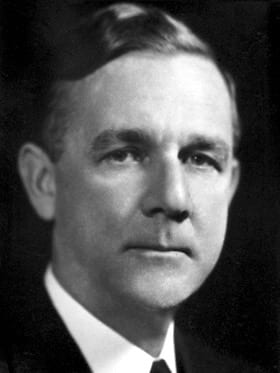George Hoyt Whipple
George Hoyt Whipple (1878-1976) was an American physician, pathologist and medical researcher.
Physician, pathologist and medical researcher. Whipple’s main researches were concerned with anaemia and the physiology and pathology of the liver.
1934: Nobel Prize for Physiology or Medicine (along with George Minot and William Murphy) for this work on the therapeutic value of liver in the treatment of pernicious anaemia.
Eponymously remembered for Whipple disease (1907); Tropheryma whipplei (1992) and coining the term thalassemia
Biography
- Born August 28, 1878 Ashland, NH, USA
- 1900 – A.B. Yale University
- 1905 – MD, Johns Hopkins University
- 1905-1914 – Assistant, Instructor, Associate then Associate Professor in Pathology, Johns Hopkins Medical School
- 1914 – Returned from Panama gravely ill with malaria. He was admitted to the Presbyterian Hospital in New York where he was cared for by a young intern named Allen Whipple (1881-1963). The two Whipple’s were not related but became lifelong friends
- 1914 – Professor of Research Medicine, University of California Medical School
- 1920 – Dean of the University of California Medical School
- 1921 – Professor of Pathology and Dean of the School of Medicine and Dentistry at the University of Rochester
- Died February 1, 1976 Rochester, NY, USA
Medical Eponyms
Whipple disease (1907)
Rare multi-system disorder secondary to chronic bacterial infection. Affecting the gastrointestinal tract most frequently. Chronic infection of the intestinal mucosa with the bacterium Tropheryma whipplei, leads to a lymphostasis; abdominal pain; malabsorption syndrome with diarrhea; and weight loss.
Tropheryma whipplei (1992/2001)
Gram-positive Actinobacteria responsible for chronic gastrointestinal infections and endocarditis . From Greek τροφή trophê, “nourishment, food” and ἔρυμα eruma, “fence, a defence against, barrier”. In 2001 Tropheryma whippelii was renamed Tropheryma whipplei, correcting the spelling of Whipple’s name after the original posthumous naming [La Scola, 2001]
Tropheryma whippelii or whipplei ?
We have identified the uncultured bacillus associated with Whipple’s disease. The phylogenetic relations of this bacterium, its distinct morphologic characteristics, and the unusual features of the disease are sufficient grounds for naming this bacillus Tropheryma whippelii gen. nov. sp. nov.
Relman NEJM, 1992
Thalassemia
The term ‘thalassemia’ was coined in 1932 by George Hoyt Whipple of the University of Rochester in Rochester, New York. The term is derived from the Greek words ‘thalassa’ (Θάλασσα) meaning ‘sea’ and the suffix -aima (αίμα) or ‘blood,’ denoting the high prevalence of the disorder in people originating from the Mediterranean and Black Seas.
Cooley had described a clinical entity, and it may be wise to use his name to distinguish this disease. We do not like the term “erythroblastic anemia” used by Cooley, as there is nothing especially characteristic about this feature of the blood. The disease is limited almost wholly to Italians, Greeks and Syrians, i. e., to the people originating about the Mediterranean Sea. For this reason the term “thalassemia,” derived from the Greek Θάλασσα , meaning the great sea and used to designate the Mediterranean, may have an appeal.
GH Whipple , WL Bradford. 1932: 364
Major Publications
- Whipple GH. A hitherto undescribed disease characterized anatomically by deposits of fat and fatty acid in the intestinal and mesenteric lymphatic tissues. Bulletin of the Johns Hopkins Hospital. 1907; 18: 382–393. [Whipple disease]
- Goodpasture EW, Whipple GH. Acute haemorrhagic pancreatitis. Surgery, Gynecology and Obstetrics. 1913; 17: 541-47.
- Robscheit-Robbins FS, Whipple GH. Blood regeneration in severe anaemia. II. Favorable influence of liver, heart and skeletal muscle in diet. Amer J Physiol. 1925;72:408-418
- Hooper CW, Robscheit-Robbins FS, Whipple GH. Blood regeneration following simple anemia. V. The influence of Blaud’s pills and hemoglobin. Amer J Physiol. 1920;53(2):263-282
- Whipple GH, Robscheit-Robbins FS. Blood regeneration in severe anemia. I. Standard basal ration bread and experimental methods. Amer J Physiol. 1925;72(3):395-407
- Whipple GH, Robscheit-Robbins FS. Blood regeneration in severe anemia. IV. Green vegetable feeding. Amer J Physiol. 1925;72(3):431-435
- Whipple GH, Robscheit-Robbins FS. Blood regeneration in severe anemia. V. Influence of striated and smooth muscle feeding. Amer J Physiol. 1927;79(2):260-270
- Whipple GH, Robscheit-Robbins FS. Blood regeneration in severe anemia. VII. Influence of dairy products on hemoglobin production. Amer J Physiol. 1927;79(2):280-288
- Whipple GH, Robscheit-Robbins FS. Blood regeneration in severe anemia. VIII. Influence of bone marrow, spleen, brains, pancreas feeding. The question of organic iron in the diet. Amer J Physiol. 1927;80(2):391-399
- Robscheit-Robbins FS, Whipple GH. Blood regeneration in severe anemia. IX. Influence of fresh and dried fruits. Amer J Physiol. 1927;80(2):400-410
- Whipple GH, Robscheit-Robbins FS. Blood regeneration in severe anemia. X. Assimilation and concentration of bile pigment, blood hemoglobin and muscle hemoglobin. Amer J Physiol. 1927;83(1):60-75
- Whipple GH, Robscheit-Robbins FS. Blood regeneration in severe anemia. XVIII. Influence of liver and blood sausage, veal, eggs, chicken and gelatin. Amer J Physiol. 1930;92(2):388-399
- Whipple GH, Bradford WI. Racial or familial anemia of children associated with fundamental disturbances of bone and pigment metabolism (Cooley-von Jaksch) Am J Dis Child 1932; 44(2): 336-365 [first naming of thalassemia]
References
Biography
- George H. Whipple – Biographical. nobelprize.org Nobel Media AB 2014.
- Bibliography. George Hoyt Whipple (1878-1976). WorldCat Identities
Eponymous terms
- Relman DA, Schmidt TM, MacDermott RP, Falkow S. Identification of the uncultured bacillus of Whipple’s disease. N Engl J Med. 1992 Jul 30;327(5):293-301.
- Strausbaugh LJ, Maiwald M, Relman D. Whipple’s disease and Tropheryma whippelii: secrets slowly revealed. Clin Infect Dis. 2001 Feb 1;32(3):457-463
- Dutly F, Altwegg M. Whipple’s disease and “Tropheryma whippelii”. Clin Microbiol Rev. 2001 Jul;14(3):561-583.
- Obst W, von Arnim U, Malfertheiner P. Whipple’s Disease. Viszeralmedizin. 2014 Jun;30(3):167-172
- La Scola B, Fenollar F, Fournier PE, Altwegg M, Mallet MN, Raoult D. Description of Tropheryma whipplei gen. nov., sp. nov., the Whipple’s disease bacillus. Int J Syst Evol Microbiol. 2001 Jul;51(Pt 4):1471-1479.
- Moos V, Fredricks DN. Tropheryma whippelii (Whipple’s Disease). Antimicrobe.org

